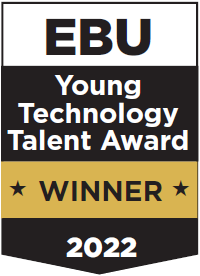
 Petri Karlsson (Yle), winner of the EBU Young Technology Talent Award 2022
Petri Karlsson (Yle), winner of the EBU Young Technology Talent Award 2022
In spring 2021, Yle investigated the use of point clouds in the workflows of visual professionals, such as those designing graphics, lighting and sets. The purpose was to create an accurate virtual 3D replica of the production site, so that everybody would have the same 3D model as a starting point for design. The concert hall at Helsinki Music Centre was chosen as the space to be 3D scanned, as Yle has weekly productions there. This complex space with widely varying height differences was well suited for comprehensive testing. While lidar scanning was a convenient technique for visualization and digital measurement of spaces, unfortunately it wasn’t possible to import the point cloud as is into all visualization software, so the space also needed to be 3D modelled on top of the point cloud.
From point cloud to Orter
In the late summer, we decided to build on this positive start by combining the point cloud and the plans of the visual professionals on a single platform. Unreal Engine was selected because of its versatile import possibilities, high-quality real-time rendering and easy programming. The project was initially referred to as a virtual production-design tool, based on the goal of transferring the designing of live television shows, fiction and events at least partially to the virtual world. Later, it was branded Orter.
Orter developed rapidly throughout autumn 2021, in cooperation with various Yle colleagues. Rami Lindholm, the foreman of Yle’s directors, had a particularly strong influence on the development work, seeing the potential of Orter at a very early stage. During the development we tried to use Unreal Engine’s built-in features as much as possible, but we also programmed completely new features; for example, four different types of camera controller, video-based motion capture workflow for virtual
human movements, and a library of widely used camera lenses and sensors, allowing the production site to be viewed as if through a real camera. However, for directors the most important feature of Orter is the CuePilot integration, which allows the director to cut between virtual cameras straight from the CuePilot timeline. Thus, entire productions can be cut in advance in the virtual world.
First user experiences
Following some pandemic-related delays, the first real technical test was carried out in March 2022, when camera locations and the positioning of the AR graphical elements were planned in Orter. The test went well, and we soon agreed with the director Rauli Valo on the virtual pre-planning of the Moves like Summeri production that aired at the end of May. The virtual design was a success: the camera positions, placement of the graphics on the projection screen, layout of the sets and cutting of the programme with CuePilot were all designed virtually. This freed up valuable time for other programme development activities.
Although Orter has so far only been used in one production at Yle, the goals set for it have mostly already been achieved. We have proved that Orter unifies the production team, significantly facilitates the director’s work and reduces the margin of error. It makes it possible for the entire production staff to gather in a virtual space that corresponds to the real production site and plan the production together.
Most of the components needed for the virtual design of a television programme are already available in Orter, but further development is ongoing. For example, the transition to version 5 of Unreal Engine will happen later this year. We are also collecting 3D models of frequently used production locations in a library and creating presets for typical camera movements.
This article was first published in issue 53 of tech-i magazine.
